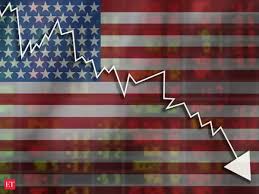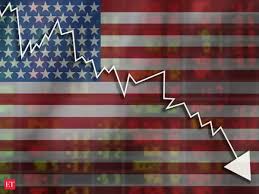
The United States' economy unexpectedly dropped in the first quarter, owing to a return in COVID-19 infections and a dip in government pandemic assistance funds, although the drop in output is deceiving because domestic demand remained high.
The Commerce Department reported on Thursday the first fall in GDP since the short and severe pandemic recession nearly two years ago, which was mostly driven by a larger trade deficit as imports increased and a slowing in the pace of inventory accumulation.
Domestic demand increased from the fourth quarter's rate, allaying fears of stagflation or a recession. Next Wednesday, the Federal Reserve is anticipated to raise interest rates by 50 basis points.
The Federal Reserve of the United States hiked its policy interest rate by 25 basis points in March and is expected to begin reducing its asset holdings soon.
"The economy is still showing some resilience, but the first-quarter GDP report signals the start of more moderate growth this year and next, largely in response to higher interest rates," said Sal Guatieri, a senior economist at BMO Capital Markets in Toronto. "Despite the contraction, the Fed has little choice but to hike aggressively in May to corral inflation."
According to the government's advance GDP estimate, GDP decreased at an annualised pace of 1.4 per cent in the fourth quarter. In the fourth quarter, the economy expanded at a solid 6.9 per cent annual rate. Reuters polled economists, who predicted GDP growth of 1.1 per cent. Estimates ranged from a 1.4 per cent rate of contraction to a 2.6 per cent rate of growth.
The economy was also harmed by supply-chain issues, labour shortages, and excessive inflation. The drop in the fourth quarter is a ruse, as GDP is still 2.8 per cent more than it was in the fourth quarter of last year, and the economy increased 3.6 per cent year on year. Furthermore, 1.7 million jobs were generated in the first quarter, and manufacturing output increased by 5 per cent.
"It is nonsense that real GDP declined," said Conrad DeQuadros, senior economic advisor at Brean Capital in New York.
However, the disparity suggests that productivity was lower in the previous quarter.
Fear of shortages as a result of the Russia-Ukraine war drove to an increase in imports. Exports fell, resulting in a substantial increase in the trade deficit, which reduced GDP growth by 3.20 percentage points, the largest since the third quarter of 2020. For the seventh quarter in a row, trade has been a drag on growth.
Businesses have turned to imports to meet demand since local producers lack the ability to increase production. Business inventories climbed at a $158.7 billion annual rate, down from a healthy $193.2 billion rate in the October-December quarter. Inventory investment reduced GDP growth by 0.84 percentage point.
Wall Street stocks were higher as investors shrugged off the GDP decline. The US dollar gained ground versus a basket of currencies. Treasury prices in the United States decreased.
Consumer spending, which accounts for more than two-thirds of U.S. economic activity, increased at a 2.7 per cent rate in the fourth quarter, up from a 2.5 per cent rate in the previous quarter, despite a knock from the winter wave of coronavirus cases caused by the Omicron variety.
The government's loss of pandemic money to households was largely compensated by growing wages in a tighter job market. Government spending declined for the second quarter in a row.
A separate data released on Thursday by the Labor Department showed that initial applications for state unemployment benefits declined 5,000 to a seasonally adjusted 180,000 for the week ending April 23. Employers are fiercely clinging to their employees, with a near-record 11.3 million job postings at the end of February.
(Source:www.reuters.com)
The Commerce Department reported on Thursday the first fall in GDP since the short and severe pandemic recession nearly two years ago, which was mostly driven by a larger trade deficit as imports increased and a slowing in the pace of inventory accumulation.
Domestic demand increased from the fourth quarter's rate, allaying fears of stagflation or a recession. Next Wednesday, the Federal Reserve is anticipated to raise interest rates by 50 basis points.
The Federal Reserve of the United States hiked its policy interest rate by 25 basis points in March and is expected to begin reducing its asset holdings soon.
"The economy is still showing some resilience, but the first-quarter GDP report signals the start of more moderate growth this year and next, largely in response to higher interest rates," said Sal Guatieri, a senior economist at BMO Capital Markets in Toronto. "Despite the contraction, the Fed has little choice but to hike aggressively in May to corral inflation."
According to the government's advance GDP estimate, GDP decreased at an annualised pace of 1.4 per cent in the fourth quarter. In the fourth quarter, the economy expanded at a solid 6.9 per cent annual rate. Reuters polled economists, who predicted GDP growth of 1.1 per cent. Estimates ranged from a 1.4 per cent rate of contraction to a 2.6 per cent rate of growth.
The economy was also harmed by supply-chain issues, labour shortages, and excessive inflation. The drop in the fourth quarter is a ruse, as GDP is still 2.8 per cent more than it was in the fourth quarter of last year, and the economy increased 3.6 per cent year on year. Furthermore, 1.7 million jobs were generated in the first quarter, and manufacturing output increased by 5 per cent.
"It is nonsense that real GDP declined," said Conrad DeQuadros, senior economic advisor at Brean Capital in New York.
However, the disparity suggests that productivity was lower in the previous quarter.
Fear of shortages as a result of the Russia-Ukraine war drove to an increase in imports. Exports fell, resulting in a substantial increase in the trade deficit, which reduced GDP growth by 3.20 percentage points, the largest since the third quarter of 2020. For the seventh quarter in a row, trade has been a drag on growth.
Businesses have turned to imports to meet demand since local producers lack the ability to increase production. Business inventories climbed at a $158.7 billion annual rate, down from a healthy $193.2 billion rate in the October-December quarter. Inventory investment reduced GDP growth by 0.84 percentage point.
Wall Street stocks were higher as investors shrugged off the GDP decline. The US dollar gained ground versus a basket of currencies. Treasury prices in the United States decreased.
Consumer spending, which accounts for more than two-thirds of U.S. economic activity, increased at a 2.7 per cent rate in the fourth quarter, up from a 2.5 per cent rate in the previous quarter, despite a knock from the winter wave of coronavirus cases caused by the Omicron variety.
The government's loss of pandemic money to households was largely compensated by growing wages in a tighter job market. Government spending declined for the second quarter in a row.
A separate data released on Thursday by the Labor Department showed that initial applications for state unemployment benefits declined 5,000 to a seasonally adjusted 180,000 for the week ending April 23. Employers are fiercely clinging to their employees, with a near-record 11.3 million job postings at the end of February.
(Source:www.reuters.com)





